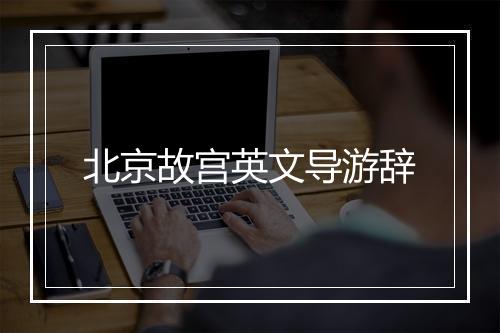北京故宫英文导游辞
forbidden city
ladies and gentlemen:
i am pleased to serve as your guide today.
it is believed that the palace museum, or zi jin cheng , got its name from astronomy folklore, the ancient astronomers divided the constellations into groups and centered them around the ziwei yuan. the constellation containing the north star was called the constellation of heavenly god and star itself was called the purple palace. because the emperor was supposedly the son of the heavenly gods, his central and dominant position would be further highlighted the use of the word purple in the name of his residence. in folkl❅ore, the term ”an eastern purple cloud is drifting” became a metaphor for auspicious events after a purple cloud was seen drifting eastward immediately before the arrival of an ancient philosopher, laozi, to the hanghu pass. here, purple is associated with auspicious developments. the word jin is self-explanatory as the imperial palace was heavily guarded and off-explanatory as the imperial palace was heavily guarded and off-limits to ordinary people.
the red and yellow used on the palace walls and roofs are also symbolic. red represents happiness, good fortune and wealth. yellow is t✄he color of the earth on the loess plateau, the original home of the chinese people. yellow became an imperial color during the tang dynasty, when only members of the royal family were allowed to wear it and use it in their architecture.
manpower and materials throughout the country were used to build the forbidden city. a total of 230,000 artisans and one million laborers were employed. marble was quarried from fangshan country mount pan in jixian county in hebei province. granite was quarried in quyang county in hebei province. paving blocks were fired in kilns in suzhou in southern china. bricks and scarlet pigmentation used on the palatial walls came from linqing in shandong province .timber was cut ,processed and hauled from the卐 northwestern and southern regions.
the structure in front of us is the meridian gate. it is the main entrance to the forbiddeษn city. it is also knows as wufenglou. min®g emperors held lavish banquets here on the 15th day of the first month of the chinese lunar year in hornor of their counties .they also used this place for punishing officals by flogging them with sticks.
qing emperors used this building to announce the beginning of the new year. qing emperor qianglong changed the original name of this announcement ceremony from ban lito ban shouto avoid coincidental association with another emperor` s name, hongli, which was considered a taboo at that time. qing dynasty emperors also used this place to hold audience and for other important ceremonies. for example,when the imperial army returned victoriously from the battlefield ,it was here that the emperor presided over the ceremony to accept prisoners of war.
<>

